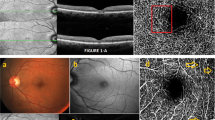Abstract
Purpose
To describe various clinical features of idiopathic juxtafoveal retinal telangiectasis group 2A or idiopathic macular telangiectasia type 2 (MacTel) on multicolor imaging (MCI) and compare imaging findings of MacTel on MCI with fundus autofluorescence (FAF).
Methods
Patients with a clinical diagnosis of MacTel based on Gass and Blodi’s classification were included. FAF and MCI images were graded qualitatively for stage of disease, margins of involvement, hyperautofluorescence on FAF (corresponding retinal atrophy on MCI), and detection of crystals. FAF and MCI were graded quantitatively for the area and number of quadrants involved, hypoautofluorescene on FAF (corresponding intraretinal pigment hyperplasia or retinal pigment epithelium [RPE] atrophy on MCI), and foci of right-angled venules.
Results
Seventy-eight eyes of forty five patients were included with both imaging modalities showing no difference with respect to staging of non-proliferative MacTel. Retinal crystals were recognized on MCI but not on FAF. Neurosensory retinal atrophy and subretinal neovascular membranes were detected using MCI with 92.3 and 83.3% sensitivity, respectively. Intraretinal pigmented hyperplasia was more accurately detected (70.1 vs 58.4%) compared with RPE atrophy on MCI. MCI showed larger area of involvement, higher number of quadrants involved (p < 0.001), and better delineation of margins (p = 0.002) compared with FAF. A higher mean number of vessel dipping foci was noted on MCI in comparison with FAF (3.34 vs 3.1).
Conclusion
Various parameters were more easily defined using MCI compared with FAF which qualifies MCI as an enface depth-resolved imaging adjunct to conventional multimodal imaging in MacTel. The ability to detect enface as well as cross-sectional imaging features makes MCI a valuable tool in MacTel.





Similar content being viewed by others
Availability of data and material
Available of reasonable request.
References
Charbel Issa P, Gillies MC, Chew EY et al (2013) Macular telangiectasia type 2. Prog Retin Eye Res 34:49–77
Gass JD, Blodi BA (1993) Idiopathic juxtafoveolar retinal telangiectasis. Update of classification and follow-up study. Ophthalmology 100(10):1536–1546
Yannuzzi LA, Bardal AM, Freund KB et al (2006) Idiopathic macular telangiectasia. Arch Ophthalmol 124(4):450–460
Spaide RF, Klancnik JM Jr, Cooney MJ (2015) Retinal vascular layers in macular telangiectasia type 2 imaged by optical coherence tomographic angiography. JAMA Ophthalmol 133(1):66–73
Saoji K, Pathengay A, Chhablani J et al (2019) Response to anti-vascular endothelial growth factor of abnormal retinal vascular net in Para foveal telangiectasia group II images on optical coherence tomography-angiography. Indian J Ophthalmol 67(1):105–108
Maruko I, Iida T, Sekiryu T et al (2008) Early morphological changes and functional abnormalities in group 2A idiopathic juxtafoveolar retinal telangiectasis using spectral domain optical coherence tomography and microperimetry. Br J Ophthalmol 92(11):1488–1491
Schmitz-Valckenberg S, Fan K, Nugent A et al (2008) Correlation of functional impairment and morphological alterations in patients with group 2A idiopathic juxtafoveal retinal telangiectasia. Arch Ophthalmol 126(3):330–335
Charbel Issa P, Troeger E, Finger R et al (2010) Structure function correlation of the human central retina. PLoS One 5(9):e12864
Tan AC, Fleckenstein M, Schmitz-Valckenberg S et al (2016) Clinical application of multicolor imaging technology. Ophthalmologica 236(1):8–18
Alten F, Clemens CR, Heiduschka P et al (2014) Characterisation of reticular pseudodrusen and their central target aspect in multi-spectral, confocal scanning laser ophthalmoscopy. Graefes Arch Clin Exp Ophthalmol 252(5):715–721
Ben Moussa N, Georges A, Capuano V et al (2015) MultiColor imaging in the evaluation of geographic atrophy due to age-related macular degeneration. Br J Ophthalmol 99(6):842–847
He L, Chen C, Yi Z et al (2020) Clinical application of multicolour imaging in central serous chorioretinopathy. Retina 40(4):743–749
Wong WT, Forooghian F, Majumdar Z et al (2009) Fundus autofluorescence in type 2 idiopathic macular telangiectasia: correlation with optical coherence tomography and microperimetry. Am J Ophthalmol 148(4):573–583
Kilic Muftuoglu I, Bartsch DU, Barteselli G et al (2018) Visualisation of macular pucker by multicolor scanner laser imaging. Retina 38(2):352–358
Yung M, Klufas MA, Sarraf D (2016) Clinical applications of fundus autofluorescence in retinal disease. Int J Retina Vitreous 2:12
Charbel Issa P, Berendschot TT, Staurenghi G et al (2008) Confocal blue reflectance imaging in type 2 idiopathic macular telangiectasia. Invest Ophthalmol Vis Sci 49(3):1172–1177
Helb HM, Charbel Issa P, Van Der Veen RL et al (2008) Abnormal macular pigment distribution in type 2 idiopathic macular telangiectasia. Retina 28(6):808–816
Müller S, Charbel Issa P, Heeren TFC et al (2018) Macular pigment distribution as prognostic marker for disease progression in macular telangiectasia type 2. Am J Ophthalmol 194:163–169
Charbel Issa P, Helb HM, Holz FG et al (2008) Correlation of macular function with retinal thickness in nonproliferative type 2 idiopathic macular telangiectasia. Am J Ophthalmol 145(1):169–175
Sallo FB, Leung I, Chung M et al (2011) Retinal crystals in type 2 idiopathic macular telangiectasia. Ophthalmology 118(12):2461–2467
Delori FC, Gragoudas ES, Francisco R et al (1977) Monochromatic ophthalmoscopy and fundus photography. The normal fundus. Arch Ophthalmol 95(5):861–868
Hu DN, Simon JD, Sarna T (2008) Role of ocular melanin in ophthalmic physiology and pathology. Photochem Photobiol 84:639–644
Tzaridis S, Heeren T, Mai C et al (2019) Right-angled vessels in macular telangiectasia type 2. Br J Ophthalmol bjophthalmol-2018-313364
Author information
Authors and Affiliations
Contributions
Guidelines for authorship adhered to as prescribed.
Corresponding author
Ethics declarations
Conflict of interest
The authors declare that they have no conflict of interest.
Commercial relationship disclosure
None.
Ethics approval
This research study was conducted retrospectively from data obtained for clinical purposes. We consulted extensively with the IRB of Pushpagiri Vitreo Retina Institute, India, who determined that our study did not need ethical approval. An IRB official waiver of ethical approval was granted from the IRB of Pushpagiri Vitreo Retina Institute, India.
Consent to participate
Obtained as required.
Consent for publication
Obtained as required.
Code availability
Not applicable.
Additional information
Publisher’s note
Springer Nature remains neutral with regard to jurisdictional claims in published maps and institutional affiliations.
Rights and permissions
About this article
Cite this article
Govindahari, V., Fraser-Bell, S., Ayachit, A.G. et al. Multicolor imaging in macular telangiectasia—a comparison with fundus autofluorescence. Graefes Arch Clin Exp Ophthalmol 258, 2379–2387 (2020). https://doi.org/10.1007/s00417-020-04878-3
Received:
Revised:
Accepted:
Published:
Issue Date:
DOI: https://doi.org/10.1007/s00417-020-04878-3




